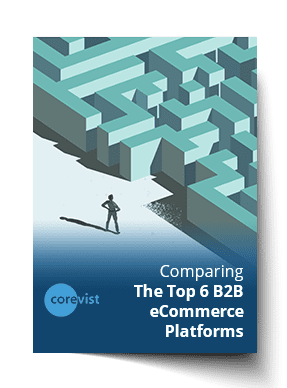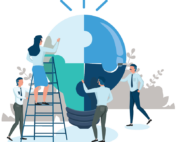Share
Author
George Anderson
Share
B2B eCommerce offers tremendous opportunities for manufacturers. Whether the goal is revenue growth, increased efficiency or a more competitive customer experience, organizations are transforming how they do business (and what profits they see from digital channels).
But what should manufacturers look for in B2B eCommerce? Are all platforms created equally?
Absolutely not. 😊
Some platforms will create unmanageable complexity for manufacturers. Others will allow companies to succeed online while focusing on their core business.
Here are 7 questions to ask as you evaluate B2B eCommerce platforms.
1. Will this B2B eCommerce platform allow us to roll out incrementally?
There are many paths to B2B eCommerce. For some manufacturers, a platform that requires launching the whole package is a heavy lift. How can you possibly dive into B2B eCommerce if you don’t have your product content together? What if your SAP ERP system isn’t configured to match your actual business processes for handling orders?
For an easy entry point to B2B eCommerce, manufacturers should look for a platform that can start with a customer portal and expand to B2B eCommerce in a future rollout. You want to give customers a portal for post-order care so they get used to digital workflows.
So where do you start?
Here’s the customer portal functionality you should look for.
- Self-service order history and status for all orders, regardless of how they were placed (phone, fax, email or EDI)
- Easy access to shipment status and tracking numbers integrated with carrier websites
- Full invoice status and history, plus real-time credit status
- The ability to pay off invoices online through self-service
Once you’ve onboarded customers to the portal, you can roll out B2B eCommerce on the same platform. Since customers already understand the value of the portal, there should be no struggle in moving their business to B2B eCommerce.
Hint: Corevist Commerce supports this progression from customer portal to B2B eCommerce. You can start with the post-order tracking portion of the application, then roll out B2B eCommerce when you’re ready. For real-life examples of this approach, check out these Corevist case studies.
Of course, an incremental approach is also critical if you need spinoff sites for multiple brands, languages or geographies. Oregon Tool took this approach with Corevist as well. We’ll talk about multiple geographies in Question 7 below.
2. Which B2B eCommerce hosting model is best for manufacturers?
This question isn’t trivial. The hosting model you choose will directly impact your IT operations — not only in the project phase, but for as long as you use the platform. If you don’t have the IT resources to support your hosting model, your choice here can impact the business and your customer experience, too.
In other words, it’s not just an IT problem.
Here are the hosting options you’ll typically find for B2B eCommerce platforms.
Hosted
With a hosted solution, the manufacturer purchases licensing for the B2B eCommerce platform and secures their own hosting for the software. Typically, the reseller who sold the license will also offer hosting, though the manufacturer could work with two different vendors here.
With a hosted B2B eCommerce platform, the manufacturer will be responsible for all customization, support and integration — or else they’ll need to engage partners to handle these things. (For more on working with multiple vendors, see Question 6 below.)
Cloud-based software as a service (SaaS)
Under a SaaS model, the platform provider manages the software and makes it available via web browser. Manufacturers choosing a SaaS B2B eCommerce platform don’t have to worry about hosting or management — the platform vendor covers it all.
For manufacturers with limited IT resources, SaaS delivery is a great option for B2B eCommerce. It relieves your team from having to perform routine maintenance and respond to issues. In a sense, the SaaS model outsources the support, hosting and management for B2B eCommerce.
Hint: This is the Corevist Commerce model.
Cloud-based platform as a service (PaaS)
Under a PaaS model, the platform provider offers a cloud-hosted framework (platform) as a service. The manufacturer must engage developers to build out and maintain their unique B2B eCommerce solution that runs on this platform.
PaaS is a good option for larger organizations that have the IT resources to take full ownership of their solution. There are caveats, however. If you choose a PaaS architecture, you’ll want to make sure you understand how platform upgrades will affect your customizations. For more on this topic, see this post: 6 Caveats For Manufacturers Considering Salesforce B2B Commerce.
3. How much SAP ERP integration do we need?
Not every manufacturer needs comprehensive SAP ERP integration. As a general rule of thumb, the more generic your transactions (i.e. the less personalized they are for each customer), the more you can get away with basic integration.
At the other end of the spectrum, you’ll need a deeper integration if your customers have unique pricing, product or inventory rules that govern their transactions.
So how do you know where you fall? Ask yourself if you need any of these features in B2B eCommerce.
- Dynamic contract pricing based on quantity, bundling and any other relevant SAP business rules.
- Customer-specific catalogs or picklists driven by SAP logic.
- Intelligent error messaging (driven by SAP business rules) to help customers create error-free orders.
- Instant order posting from B2B eCommerce to SAP (so customers know they’ve claimed the inventory they ordered).
- Full history and real-time status from SAP for all orders, regardless of how they were placed (phone, fax, email, EDI or B2B eCommerce).
- Real-time credit status (so customers know if their order will go on credit block).
- Full status and history for all invoices, plus the ability to pay them off online.
If you need any of these features, you should think carefully about SAP integration.
4. Will this B2B eCommerce platform integrate with our SAP system?
B2B eCommerce platforms divide over the question of SAP integration.
Conventional platforms like Magento, Salesforce or SAP Commerce Cloud were built to stand on their own. With their own databases and backend architecture, they will always try to act as the system of record for all B2B eCommerce data — whether customers, products or transactions.
For manufacturers whose business depends on SAP ERP, that presents a problem. The B2B eCommerce platform will always require duplication and synchronization of data.
Arguably, that’s fine for data points that don’t change often (like the SKUs a customer is allowed to buy or related products within the catalog). However, real-time integration is required for things like inventory, dynamic contract pricing, SKU substitutions, credit status and instant order posting.
If you choose a standalone B2B eCommerce platform, you’ll need a complex, custom middleware integration to deliver these features. That gets pretty complex.
The alternative here is a B2B eCommerce platform that’s actually built for manufacturers — one that includes SAP integration. That’s the thinking behind Corevist Commerce.
FREE Chart
Compare Top 6 B2B Platforms
Find your best fit based on revenue size, complexity, and depth of SAP integration required. Compare SAP Commerce Cloud, Salesforce B2B Commerce, and more.
5. How much IT complexity can we take on?
Manufacturers who choose a standalone B2B eCommerce platform should think carefully about SAP integration. One way or another, you’ll have to keep that standalone platform synchronized with SAP. You’ll need additional software and IT resources to make this work.
- Third-party integration platform — either iPaaS or middleware. You’ll need to license this software, implement it and maintain it.
- Dedicated professionals to manage both the integration platform and B2B eCommerce. You can hire these in-house or outsource them.
It makes sense to outsource support and management for your integration platform — but this doesn’t address the fundamental weakness of that architecture. When your customer experience in B2B eCommerce depends on duplication and synchronization of data, you’re taking on a lot of complexity. This complexity can directly impact customer experience if something goes wrong.
For manufacturers that can’t justify this complexity, a B2B eCommerce platform that includes deep SAP integration makes more sense. The key is to know what resources you can assign to your integration (and plan accordingly as you evaluate platforms).
6. How many vendors do we want to deal with?
By now, the picture should be clear.
Manufacturers that choose a standalone B2B eCommerce platform will need to coordinate with multiple vendors. This list is by no means exhaustive, but it’s a good start.
- B2B eCommerce platform vendors
- Software licensing
- Software hosting (if not SaaS)
- Software implementation
- Software support
- Integration platform vendor(s)
- Licensing, hosting (if not iPaaS), implementation and support. You may need one vendor or several to cover these.
- SAP ERP vendors or internal resources (you’re already paying for these, but they do add to the number of vendors you have to work with)
- ERP licensing
- ERP hosting
- ERP support
That’s a lot of coordination and data duplication. There are many places where things can go wrong. While large organizations can handle this complexity, other companies can’t justify it.
The alternative is a managed, cloud-hosted B2B eCommerce platform that includes SAP ERP integration from the start. This is the Corevist model, and it greatly reduces the number of vendors you’ll have to work with.
- A single B2B eCommerce platform vendor covers licensing, hosting, SAP integration, implementation and support. You have one vendor to call if something goes wrong.
- Your existing ERP vendors or resources simply continue managing and supporting SAP ERP.
7. How are we going to roll out in multiple geographies?
Not every manufacturer will have this question. But for those that do, the choice of B2B eCommerce platform has a big impact on the cost and ease of global rollouts.
If you need separate B2B eCommerce experiences for different brands, geographies or customer segments, it’s worth asking how a given platform will fulfill this requirement (or not). What will you have to rebuild in each case? What can you reuse? Is that time and money well spent?
Here’s where a managed solution really shines — especially if it includes prebuilt, reusable SAP integration architecture (as Corevist Commerce does).
If your different brands and geographies all reside in the same SAP ERP system (or if you have separate SAP systems that are templatized and very similar), then a solution like Corevist Commerce allows you to reuse your architecture investment, including SAP integration, in each new rollout. You can start with the geography or line of business that best reflects the requirements of your other segments. Treating that implementation as your flagship site, you can launch there to work out the kinks, then roll out additional spinoff sites for the other segments. The spinoff sites reuse your architecture while offering the control you need for each brand or geography.
Without a solution like this, additional rollouts will be more costly and time-consuming. You’ll have to build separate integrations and B2B eCommerce solutions for each segment. That creates a heavier lift — not only in the project phase, but for the ongoing life of the B2B eCommerce program.
This is one reason Corevist Commerce is built on a configurable SAP integration. We make it easy for manufacturers to stand up a global B2B eCommerce program on a single, scalable platform.
Case Study:
Lean, mean, global B2B eCommerce rollout
Learn how Oregon Tool launched Corevist Commerce in numerous geographies with reusable SAP integration architecture. The best part? 325% revenue growth.











